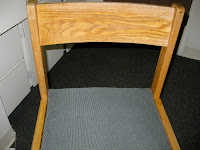There are 5 main areas of ergonomics used to critique a design: safety, comfort, ease of use, performance, and aesthetics. Failing to address all five of these, or focusing too much on one and not enough on others, often leads to an unsuccessful design. The designer of the following product has committed the latter offense. Although the design is successful in some aspects of ergonomics, it is equally
unsuccessful in all the others.
I give you, my dorm room desk chair:
Since you as the reader can only
see the chair, I will start with the area of ergonomics that is most apparent in the photo: aesthetics. This chair appears very
ordinary. It simply looks like a platform, backrest, and legs, almost identical any other chair ever designed.
This description is already one strike against the chair; designers should aim to produce products that are innovative and creative, not average or boring. With a product as common as the chair, it would be much more helpful to add something
new and exciting to the design, something that will surprise and intrigue viewers. The wood frame has a yellowy tinge that just makes it look cheap and (for lack of a better word) tacky. Similarly, the upholstery is an uninviting washed-out shade of green featuring an extremely boring (and tiny) textured pattern. Even the angles of the chair are uninspired; the chair features almost exclusively 90 degree angles which at first glance, do not appear to be very compatible with the human figure. The sum of its unattractive parts is no better than each individual eye-sore, making the chair very aesthetically displeasing.

Working backwards on the list I will move next to performance, an area that seems to have been much more important to the designer than looks. As far as chairs go, this ones performs quite adequately. It produces a space for me to sit down, and feels very stable as I do so while writing this blog. Because the only necessary function for a chair is to stand, and provide a seat for a single person, I assert that this product performs very well. It does exactly as it should, no more and no less.
The ease of use of this product is however, not so satisfactory. I'll admit it, as far as the action of sitting in the chair goes, this product
is very easy to use. The height of the seat is neither to high or too low, so that it is easy for average sized people to lower themselves onto it. The stability of the design also make it easy to sit on, because one must not worry about whether it is going to tip over. However, one action that is
not easy to perform with this chair is moving it while sitting in it. Most office/desk chairs feature wheels on the bottom that make it easy to maneuver the chair in and around the desk. This chair however, stands on planks of wood connecting the two legs at each side which makes it very difficult to slide around or scoot closer to the desk, while someone is occupying it. With a different lower half, I feel this design could be much easier to use.
This next category is again, rather disappointing: comfort. The only aspect of this chair that even
attempts to be comfortable is the actual seat, adequately cushioned and not
completely unpleasant to sit one's behind upon. The other half of design that
should be considered comfortable however, the backrest, is not. As you can see, the backrest has no cushion on it. For someone like me, whose spine tends to protrude when my back is not perfectly straight, direct contact with the hard wood is very unpleasant. I realize not everyone has this problem, but that is also not the only issue with the backrest. The rest only supports a small portion of an occupant's back, and stands so vertically that it is only comfortable when the person using it sits with flawless posture. Perhaps this design aims to encourage good posture, but considering the amount of time college students spend sitting in these chairs doing homework (or writing blogs), a backrest that wouldn't jab into a person's back when he/she attempted to scoot down into a more comfortable position, would have been a smart move.

The last aspect of ergonomics, safety, prevails in this design. As I said before, this chair is very stable. When used correctly, it is very hard to tip over. Even when my vertically-challenged roommate uses it as a stool to reach the top of our closet, it remains a very solid structure. This may explain the absence of wheels on the bottom of the chair; having tried to use wheeled office chairs as stools in the past, I know first hand that they are not stable or safe when stood upon. Perhaps the designer when creating this chair, or the school when choosing this product, realized that college-aged persons would be very likely to stand on them. Although it may not be the most efficient platform, wood-plank supports make this chair notably safe to use.
As a whole, this chair is an ugly, uncomfortable, awkward design. It seems obvious to me that the designer and school had two main areas of ergonomics in mind when creating/selecting this product: performance, and safety. The chair is a stable, solid platform for any college student's backside. The areas that seem to have been neglected though, are equally important in any design: comfort, ease of use, and aesthetics. If the school had chosen a product that served not only their ergonomic desires, but all five, I think we could all be a lot more satisfied with it.

